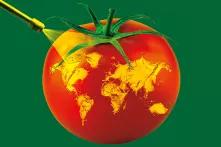
Insufficient attention is being paid to pesticides accumulating in the soil, where they exert direct and indirect adverse effects on soil life – sometimes for decades.

In healthy soils very high levels of biodiversity can be observed: Soil is home to a quarter of all known species on Earth. Soil life is so abundant that a shovelful of healthy soil contains more living organisms than there are people on Earth. It is hard to overestimate what all this teeming life in the soil is capable of achieving – tens of thousands of underground species of invertebrates, bacteria, and fungi are constantly filtering our water, recycling nutrients, counteracting soil-borne diseases, building humus, sequestering greenhouse gases, and regulating the climate. So soil is not only the substrate on which we grow our food – but also a non-renewable resource that must be treated with care.
Most pesticides are designed to be toxic to organisms and it is all the more concerning that nearly two-thirds of all agricultural land worldwide is contaminated with at least one pesticide active ingredient. In Europe, soil analyses revealed that more than 80 percent of 317 agricultural topsoils tested contained pesticide residues. The most commonly found and most highly concentrated pesticides were the long-banned insecticide DDT, the herbicide glyphosate as well as its degradation product AMPA, and broad-spectrum fungicides such as boscalid, epoxiconazole, and tebuconazole.
Pesticide residues in the soil affect soil life. A systematic review of nearly 400 published studies found: Pesticides harm organisms that are vital for maintaining healthy soils in over 70 percent of the more than 2,800 experiments included in this review. These effects were observed at all organismic levels: bacteria, fungi, and soil fauna. Pesticide residues in soil are also associated with the decline of earthworms, microorganisms, and symbiotic mycorrhizal fungi – which provide not only nutrients to plants but also keep them healthy.
Ecotoxicological research on pesticides has always focused specific effects, for example on how insecticides affect beneficial soil insects, or how fungicides affect soil fungi. However, pesticides have an impact that goes far beyond that: They usually have negative effects on a wide range of non-target organisms. One example is glyphosate – the most widely used herbicide in the world. It affects soil life in a variety of ways, directly and indirectly: The use of glyphosate can harm soil bacteria and mycorrhizal symbiosis with the roots of grapes. Even 11 months after application, the herbicide can still be affecting the nutrient composition of the entire grape plant. Glyphosate herbicides reduce activity and reproduction of earthworms and can force tiny springtails from the soil to the surface, making them more vulnerable to predators. These impacts on soil life can further impair water infiltration after heavy rains – and lead to more glyphosate contamination in water bodies.
Pesticide use can also harm subsequent crops. Nevertheless, this is hardly taken into account in risk assessment. Persistent glyphosate residues in soil have been shown to alter many plant processes: They change the regulation of plant defence systems against diseases and harmful soilborne fungi. Glyphosate residues in livestock feed can even be transferred to manure and affect the growth of fertilized crops the following year. Pesticides containing intentionally added microplastics also contribute to the pollution of soils. The use of such plastic-coated synthetic agrochemicals is rising, with producers marketing their controlled-release function. According to a 2019 report from the European Chemicals Agency (ECHA), microplastics added intentionally to fertilizers, pesticides and seed coatings account for nearly half of the approximately 51.500 tonnes of microplastics used each year in the European Economic Area.
Environmental experts are troubled by the many negative effects that pesticides have had on soil life for decades. They are calling for greater consideration of biodiversity and soil health issues when assessing the environmental risks of pesticides. In addition to common soil life, many other species also spend part of their life cycle in the soil: ground beetles, ground-nesting bees, or amphibians. Soil contamination with pesticides should therefore be considered as part of the context of the drastic decline in biodiversity as a whole.

